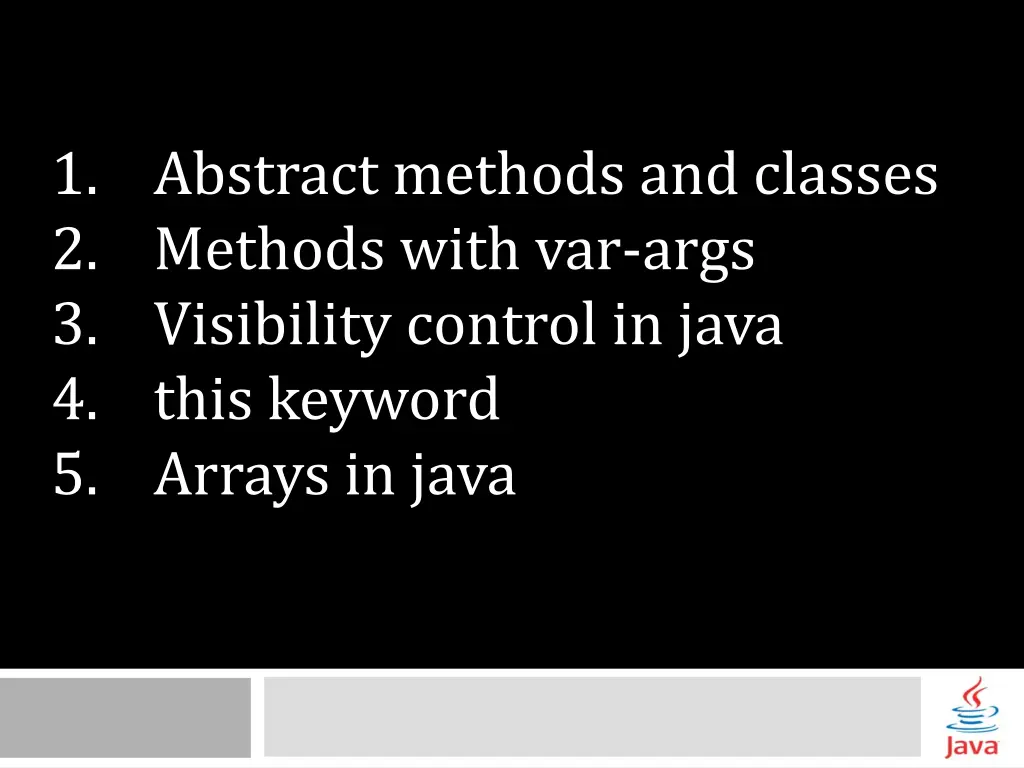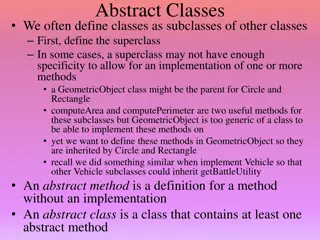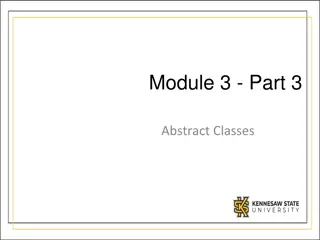
Understanding Abstract Classes and Varargs in Java
Delve into the concepts of abstract methods and classes, visibility control, the 'this' keyword, and arrays in Java. Explore the significance of abstract classes and methods, along with practical examples, and learn about the flexibility of methods with variable arguments (varargs).
Download Presentation

Please find below an Image/Link to download the presentation.
The content on the website is provided AS IS for your information and personal use only. It may not be sold, licensed, or shared on other websites without obtaining consent from the author. If you encounter any issues during the download, it is possible that the publisher has removed the file from their server.
You are allowed to download the files provided on this website for personal or commercial use, subject to the condition that they are used lawfully. All files are the property of their respective owners.
The content on the website is provided AS IS for your information and personal use only. It may not be sold, licensed, or shared on other websites without obtaining consent from the author.
E N D
Presentation Transcript
1. Abstract methods and classes 2. Methods with var-args 3. Visibility control in java 4. this keyword 5. Arrays in java
Abstract Methods and Classes A class declared as abstract is known as abstract class. It needs to be extended and its method implemented. It cannot be instantiated. Syntax to declare the abstract class abstract class <class_name>{ } Abstract Method A method that is declared as abstract and does not have implementation is known as abstract method. Syntax to define the abstract method abstract return_type <method_name>(); //no braces{}
Example abstract class Bike { } abstract void run( ); class Honda extends Bike { void run() { } System.out.println("running safely.."); public static void main(String args[]) { Bike obj = new Honda(); obj.run(); } }
//example of abstract class having constructor, field and method abstract class Bike { int limit=30; Bike( ) { System.out.println("constructor is invoked"); } void getDetails() { System.out.println("it has two wheels"); } abstract void run(); } class Honda extends Bike{ void run(){ System.out.println("running safely.."); } public static void main(String args[]){ Bike obj = new Honda(); obj.run(); obj.getDetails(); System.out.println(obj.limit); } }
Methods with varargs Varags represents variable length arguments in methods. It makes the code simpler and flexible. <access specifier> <static> void method-name(object arguments) in which Object is type of an argument. Ellipsis ( ) is the key to varargs and arguments is the name of variable.
Thus varargs allows us to declare a method with the unspecified number of parameters. The varargs must be the final argument in the argument list of a method. Example : Public void sample(String username, String password, String mailId); This method can be replaced by varargs: public void sample(String var_name)
Example program for varargs class Exampleprg { Exampleprg (String person) { for(String name: person) { System.out.println( Hello + name); } } public static void main(String args[]) { Exampleprg( John , Janny , Janardan ); } }
ACCESS MODIFIERS Visibility modifiers also known as access modifiers. To restrict the access to variables and methods outside class access specifiers are used Java provides the following access modifiers Public Friendly/Package (default) Private Protected Private protected
PUBLICACCESS Any variable or method is visible to the entire class in which it is defined. What if we want to make it visible to all classes outside the current class?? current class?? This is possible by simply declaring the variable or method as public . public int number; public void sum( ) { ..} What if we want to make it visible to all classes outside the A variable declared as public has widest possible visibility and accessible everywhere.
FRIENDLY ACCESS When no access modifier is specified, the member is known as friendly level of access. The difference between the public and the friendly access is that public modifier makes the field visible in all classes regardless of their package. while the friendly access make them visible only within the current package and not within the other packages. This is also known as package access.
PROTECTEDACCESS Protected access makes the field visible not only to all classes and subclasses in the same package but also to subclasses in other package. The visibility level of the protected field lies between the public and the friendly access. Non subclasses in other packages cannot access the protected members
PRIVATE ACCESS Gives highest degree of protection. They are accessible only within their own class. They cannot be inherited by their subclass and hence not visible in it. A private method is like a final method.
Private protected Access Specifier The field which uses two keyword private and protected together. Example private protected int a; Provides a visibility level in between the protected access and private access. This modifier makes the fields visible in all subclasses regardless of package. Not accessible by other classes in same package.
Access Modifier Public Protected Friendly Private Private protected Access Location Same class Yes Yes Yes Yes Yes Subclass in same package Yes Yes Yes Yes No Other classes in same package Yes Yes Yes No No Subclasses in other package Yes Yes No Yes No Non subclasses in other package Yes No No No No
this keyword When the instance method or constructor being called by an object, then the object is called object under execution which is always pointed by this pointer. The members of the current object such as constructor or instance variables can be referred by using this pointer.
this keyword Following are the uses of this keyword. 1. this keyword can be used to refer current class instance variable. 2. this() can be used to invoke current class constructor. 3. this keyword can be used to invoke current class method (implicitly) 4. this can be passed as an argument in the method call. 5. this can be passed as argument in the constructor call. 6. this keyword can also be used to return the current class instance.
Problem Without this Keyword class student{ int id; String name; In the example, parameter (formal arguments) and instance variables are same that is why we are using this keyword to distinguish between local variable and instance variable student(int id, String name){ id = id; name = name; } void display(){System.out.println(id+" "+name);} public static void main(String args[]){ student s1 = new student(111,"Karan"); student s2 = new student(321,"Aryan"); s1.display(); s2.display(); } Output: 0 null 0 null }
Solution of the above problem by this keyword class Student{ int id; String name; student(intid, String name) { this.id = id; this.name = name; } void display(){System.out.println(id+" "+name);} public static void main(Stringargs[]) { Student s1 = new Student(111,"Karan"); Student s2 = new Student(222,"Aryan"); s1.display(); s2.display(); } }
class Student{ int rollno; String name,course; float fee; Student(int rollno,String name,String course){ this.rollno=rollno; this.name=name; this.course=course; } Student(int rollno,String name,String course,float fee){ this(rollno,name,course);//reusing constructor this.fee=fee; } void display(){System.out.println(rollno+" "+name+" "+co urse+" "+fee);} }
class TestThis{ public static void main(String args[]){ Student s1=new Student(111,"ankit","java"); Student s2=new Student(112,"sumit","java",6000f ); s1.display(); s2.display(); }}
Garbage Collection Objects are dynamically allocated by using new operator. Such objects are destroyed and their memory must be released for later reallocation. In java, the destruction of object takes place automatically. Garbage collection is a process in which the memory allocated to objects, which are no longer in use can be reclaimed for further use or free.
Garbage Collection The garbage collection is a technique, which handles the destroying of the objects in java. There is no need to destroy the object explicitly. The object does not become garbage until all the references have been dropped. The garbage collector runs as a separate low level priority thread.
Arrays Array is a collection of similar type of elements that have contiguous memory location. Array provides a convenient means of grouping related information. We can store only fixed elements in an array. Array is index based, first element of the array is stored at 0 index.
Advantage of Array Code Optimization: It makes the code optimized, we can retrieve or sort the data easily. Random access: We can get any data located at any index position. Disadvantage of Array Size Limit: We can store only fixed size of elements in the array. It doesn't grow its size at runtime.
Types of Array There are two types of array. Single Dimensional Array Multidimensional Array
Single Dimensional Array A list of items are given in one variable name using only one subscript. Syntax to Declare an Array in java dataType[ ] arrayRefVar; (or) dataType [ ]arrayRefVar; (or) dataType arrayRefVar[ ]; Instantiation of an Array in java arrayRefVar=new datatype[size];
Example of single dimensional java array class B { public static void main(String args[]) { int a[]=new int[5]; //declaration and instantiation a[0]=10; //initialization a[1]=20; a[2]=70; a[3]=40; a[4]=50; //printing array for(int i=0; i<a.length; i++) //length is the property of array System.out.println(a[i]); }}
Declaration, Instantiation and Initialization of Java Array We can declare, instantiate and initialize the java array in single statement together by: int a[]={33,3,4,5}; //declaration, instantiationand initialization class B{ public static void main(String args[]) { //declaration, instantiation and initialization int a[]={33,3,4,5}; //printing array for(int i=0;i<a.length;i++) System.out.println(a[i]); } }
Passing Java Array in the method class B{ static void min(int arr[]) { int min=arr[0]; for(int i=1;i<arr.length;i++) if(min>arr[i]) min=arr[i]; System.out.println(min); } public static void main(String args[]) { int a[]={33,3,4,5}; min(a); //passing array in the method }}
Multidimensional array In such case, data is stored in row and column based index (also known as matrix form). Syntax to Declare Multidimensional Array in java dataType[ ][ ] arrayRefVar; (or) dataType [ ][ ]arrayRefVar; (or) dataType arrayRefVar[ ][ ]; (or) dataType [ ]arrayRefVar[ ];
Example to instantiate Multidimensional Array in java int[ ][ ] arr=new int[3][3]; //3 row and 3 column Example to initialize Multidimensional Array in java arr[0][0]=1; arr[0][1]=2; arr[0][2]=3; arr[1][0]=4; arr[1][1]=5; arr[1][2]=6; arr[2][0]=7; arr[2][1]=8; arr[2][2]=9;
Example of Multidimensional java array class B { } public static void main(String args[]) { int arr[][]={{1,2,3},{2,4,5},{4,4,5}}; for(int i=0;i<3;i++) { for(int j=0;j<3;j++) { } System.out.println(); } } //declaring and initializing 2D array System.out.print(arr[i][j]+" ");
Addition of 2 matrices class B { public static void main(String args[]) { int arr[][]={ {1,2,3},{2,4,5},{4,4,5} }; for(int i=0; i<3; i++) { for(int j=0; j<3; j++) { System.out.print(arr[i][j]+" "); } System.out.println(); } } }






















